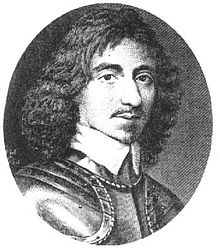Battle of Langport
| date | July 10, 1645 |
|---|---|
| place | Langport , near Yeovil , Somerset |
| output | Victory of the parliamentary troops |
| Parties to the conflict | |
|---|---|
|
English Parliament |
Royal troops |
| Commander | |
|
Sir Thomas Fairfax |
|
| Troop strength | |
| 20,000 | 3,000 horsemen and an unknown number of foot soldiers |
| losses | |
|
unknown |
unknown |
The Battle of Langport ( English Battle of Langport ) in the English Civil War was a victory of the parliamentary troops, who defeated the last remaining loyal army on July 10, 1645 and thus got final control over the west of England . Previously, the west of the country had been the main supply area for the royal troops for reinforcements, resources and imports.
campaign
The city of Taunton was conquered in June 1644 for Parliament by Robert Devereux and his army. But after he had to surrender at the Battle of Lostwithiel in Cornwall in September of that year, the Whites began to besiege Taunton. Before the city could be conquered, Sir William Waller appeared with a relief army at the end of November and freed the city from its besiegers.
The setbacks for the parliamentary army in the southwest led to the formulation of the " Self-denying Ordinance " and the establishment of the " New Model Army " in the winter of 1644/45 .
In early 1645, King Charles I commissioned Lord Goring to retake Taunton and other parliamentary outposts to the west. This prompted Parliament at the end of April, as a countermeasure, to order the main body of the New Model Army under the orders of Sir Thomas Fairfax to the west. Goring then withdrew his troops to meet the main royal army at Oxford. Fairfax now broke off its march west to besiege Oxford. The armies did not clash, however, as the king and the main part of the army under Prince Ruprecht of the Palatinate marched north, while Goring resumed the siege of Taunton.
When the King learned of the siege of Oxford by Fairfax in Staffordshire in late May, the King asked Goring to join him again while attacking Leicester himself to dissuade Fairfax from his siege of Oxford. On June 14, 1645, Fairfax and the main body of the New Model Army won a decisive victory over the royal army at the Battle of Naseby . Under him served as Lieutenant General of the Cavalry Troops Oliver Cromwell . After retaking Leicester, previously looted by the Royals, four days later, he turned south again to terrorize Taunton. The defeated king has since withdrawn to Wales in the hope of being able to raise new troops there or to receive support from Ireland.
Fairfax's army reached Beaminster on July 4 , where Goring was told that Goring had abandoned the siege of Taunton. This withdrew in the direction of the loyal fortress of Bridgwater , since his army was clearly outnumbered by Fairfax. From Taunton, Fairfax joined a division under the command of Colonel Ralph Weldon.
Fairfax reached Yeovil on July 7th . He sent part of his army under the command of Major General Edward Massey in the direction of Taunton, since Goring had sent a cavalry detachment there for diversion. This was defeated on July 8th by Massey at Ilminster . On July 10th, Fairfax and Goring's armies came together.
The battle
Lord Goring had taken a strong defensive position, not least to allow his slow artillery and supply train to retreat. His main troops were defending a north-south rise a mile east of Langport. Before this rise was a swampy valley and the Wagg Rhyne River . Only a narrow path, lined with trees and hedges, led through a ford over the river and up the hill. Lord Goring posted two cannons up that path that could fire along the road. Experienced Welsh foot soldiers holed up in the hedges. Goring hoped that this would require Fairfax to perform time-consuming evasive maneuvers.
Fairfax, however, insisted that his cavalry's superior morale would offset the advantage of Goring's position. While his artillery gorings destroyed both cannons, Fairfax sent 1,500 musketeers through the swamps to drive the Welsh infantry out of the hedges. Then he ordered two cavalry "divisions" (regiments in numbers, actually) to attack the hill along the road. Most of these two regiments were fanatical Puritan veterans from Oliver Cromwell's "Ironsides" regiment.
Major Christopher Bethel's first division galloped up the road in rows of four, routing two royal regiments. A third royal regiment counterattacked but was attacked by Major John Desborough's second parliamentary division and forced to retreat. As more and more parliamentary troops stormed up the hill, Lord Goring's troops fled.
Cromwell and his troops waited on the hill for his troops to reform and then began to pursue the royal troops. 3 kilometers further Lord Goring also tried to gather his troops, but failed in the face of the onrushing Cromwell's troops.
Result
Lord Goring's army was the last intact army available to the king. After Naseby, their defeat meant another heavy blow.
On July 23rd, Fairfax captured Bridgewater and on September 10th, Bristol . These conquests isolated the west of England from the rest of the royal troops who still held Oxford and other cities in the Midlands . The civil war was now limited to the elimination of these scattered garrisons by the parliamentary armies, without there being any major field battles.
Web links
Individual evidence
- Colonel HCB Rodgers: Battles and Generals of the Civil Wars , Seeley Service & Co. Ltd, 1968, hardback, 327 pages.
Coordinates: 51 ° 2 ′ 31 ″ N , 2 ° 48 ′ 4 ″ W.

